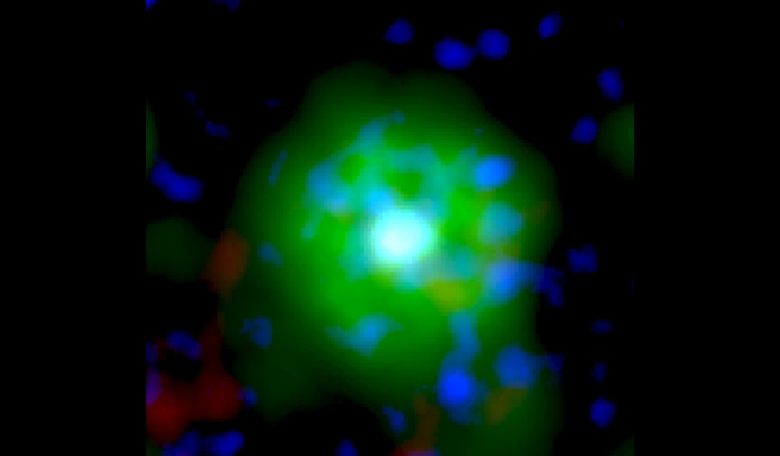Scientists studying light emitted from a distant nebula have found a star at its centre that is unlike anything seen before. Not only is it a new kind of x-ray source, the star has record breaking wind speeds and is mostly made out of the element neon giving it a bright green appearance.
Originally discovered last year, IRAS 00500+6713 – a central star embedded in a circular cloud of gas and dust known as a nebula – caught the eye of astronomers due to its most unusual properties.
Initially observations of the central object, a star known J005311, in optical light by a team headed by Lidia M. Oskinova at the University of Potsdam, Germany, found a hot, hydrogen, and helium free object with wind speeds of 16, 000 kilometres per second.
This stagerringly fast speed is comparable to the expansion velocities of a supernova ejecta, but winds belonging to material blasted out from a single stellar explosion was ruled out by Oskinova and colleagues after further investigation.
Instead, the objects stability suggested it had the hallmarks of a white dwarf; a small very dense star that was once a star like our Sun. Remnant stars such as these have exhausted all of their central nuclear fuel and lost their outer layers as a planetary nebula. What is left is a planet-sized core packed with electron-degenerate material that is usually composed of carbon (C) and oxygen (O).
More massive stars that have undergone steady carbon fusion prior to collapsing, can produce white dwarfs with cores of oxygen, neon and magnesium (ONeMg or ONe white dwarfs). These elements are difficult to observe though because the heavier elements sink towards the core.
However, when the team pointed ESA’s XMM-Newton space telescope at J005311, it’s chemical composition showed unusual amounts of silicon, sulfur and neon and evidence that the star was filled with very hot gas.
These further observations of IRAS 00500+6713 revealed another intriguing property of its central star; X-rays.
Despite no longer undergoing nuclear fusion reactions in their cores, white dwarfs can still produce x-rays by siphoning off material from a nearby companion star. As this captured matter falls onto the surface of the white dwarf, x-rays are generated as the accelerating gas heats up to several million degrees.
Curiously, the team found that these x-rays were particularly strong and not the type usually associated with white dwarf mergers.
Putting the pieces of the puzzle together, the team suggest J005311 is the merger of two white dwarfs. While this is not an uncommon event, the process normally leads to a supernova and the annihilation of both stars. In this instance, it has left behind a type of star that has never been seen before.
Whats more say the team, the star is very unstable and will likely collapse into another type of small dense star known as a neutron star within 10, 000 years.
“Its fate will therefore be to undergo core collapse and to form a neutron star,” write the authors in their recent research paper. “Over the course of this event, IRAS 00500+6713 will manage to produce its second SN [supernova], possibly in the form of a fast blue optical transient.”
This research appears in the Astronomy & Astrophysics journal.











